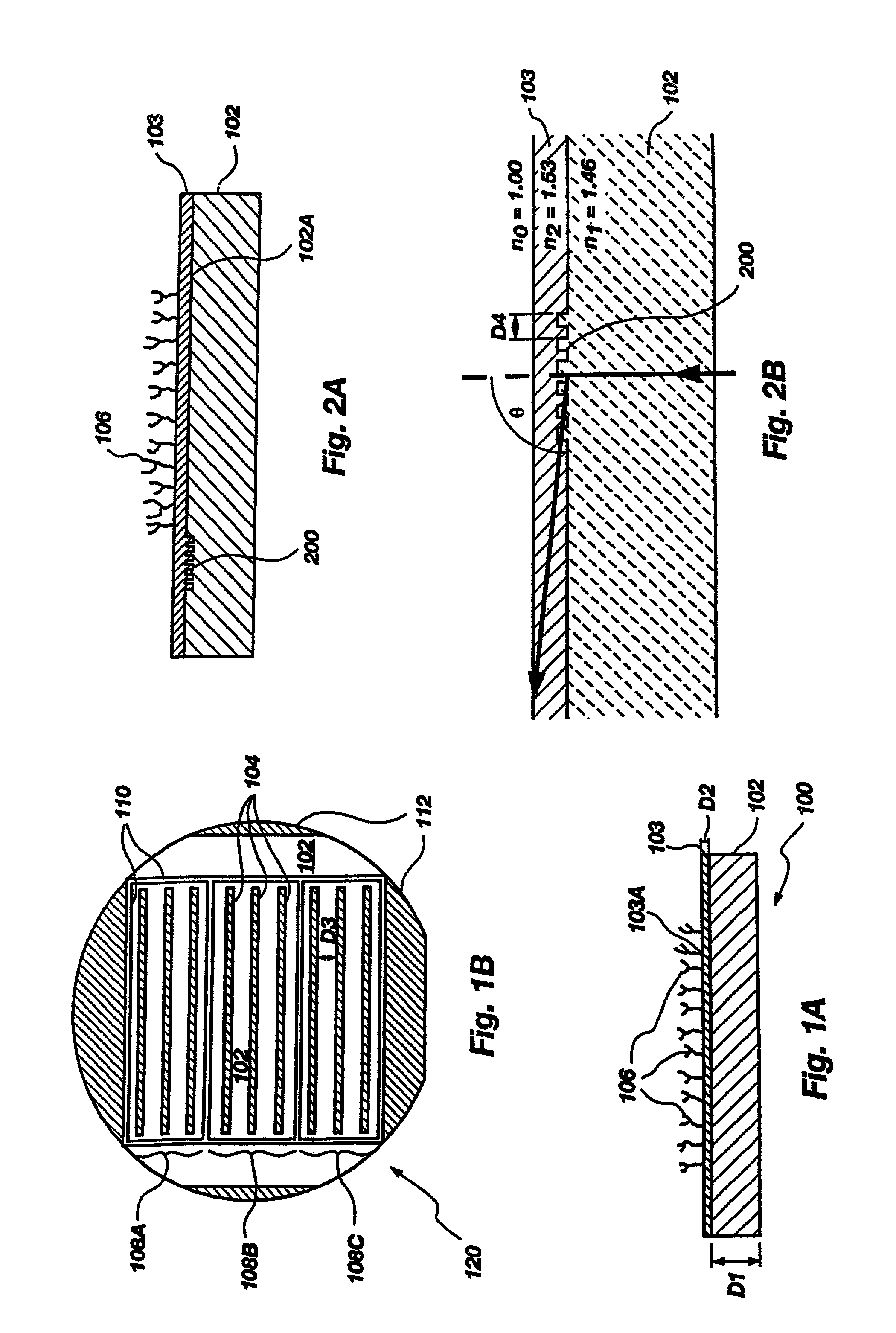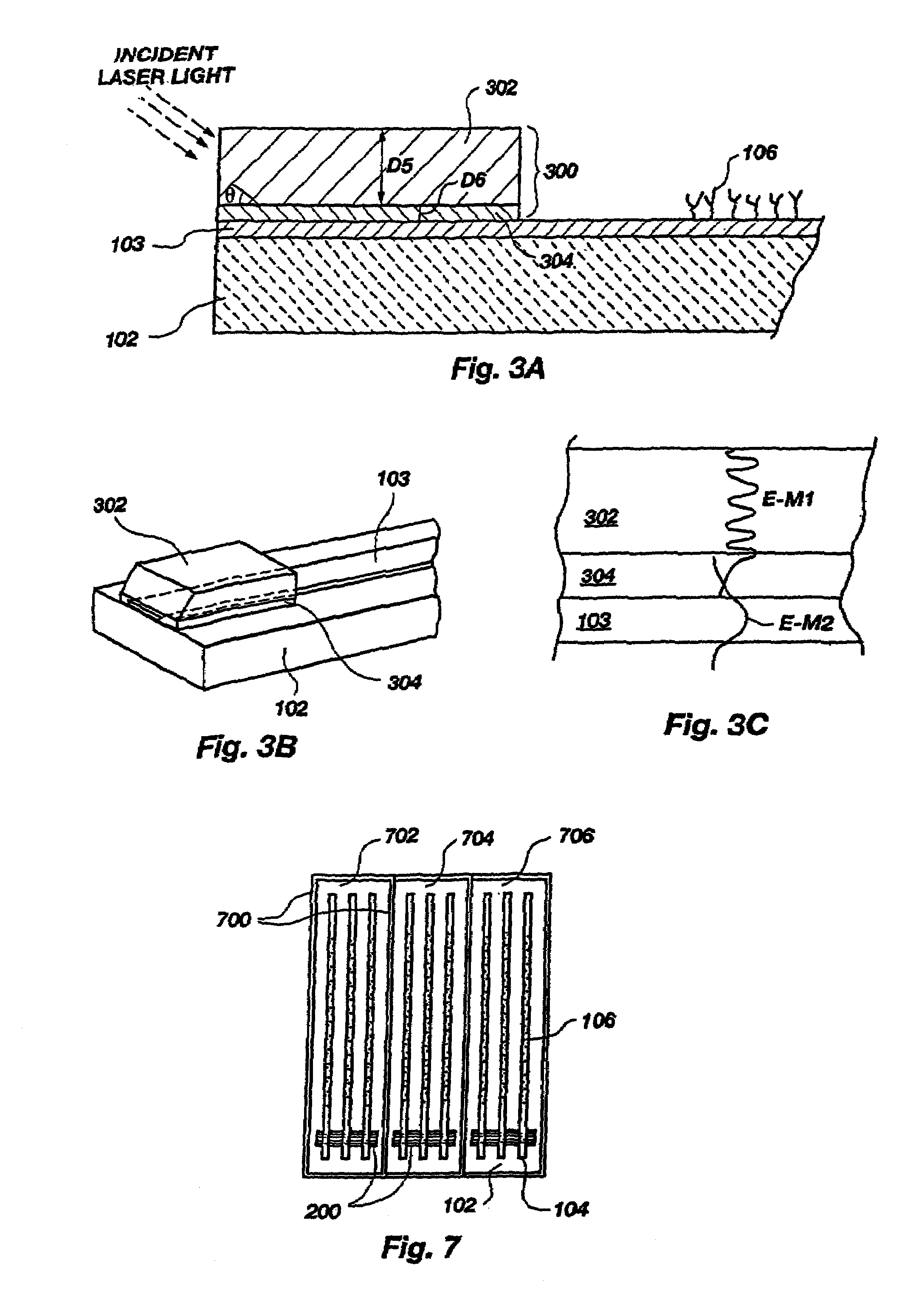Integrated optic waveguide immunosensor
an optic waveguide and immunosensor technology, applied in the field of solid-state biochemical binding assays, can solve the problems of inability to manufacture silica-on-silica waveguides, the detection limit is not believed to be available in a commercially practical and affordable immunosensor, and the detection limit is not believed to be lowered by thin-film waveguides, etc., to achieve the effect of increasing the reflection density intensity
- Summary
- Abstract
- Description
- Claims
- Application Information
AI Technical Summary
Benefits of technology
Problems solved by technology
Method used
Image
Examples
example 1
SiON Composite Waveguide Fabrication
[0043]Waveguides comprising a 1 μm thick film of Si2O3N on SiO2 have been produced as follows. A heated sample holder containing a 4 inch quartz wafer was placed in a plasma-enhanced chemical vapor deposition (PECVD) reactor. Process gasses flowed from the perimeter of the PECVD vessel, over the sample, and were then pumped out of the vessel through a central port. During deposition, the PECVD reactor was maintained at 300° C. and 1.25 Torr, with 50W of power to a 13.56 MHZ generator. The gas mixture consisted essentially of 27 standard cm3 per minute (sccm) silane (SiH4), 500 sccm nitrogen, 200 sccm ammonia, and 1300 sccm nitrous oxide. The respective inlet partial pressures were approximately 17 mTorr, 308 mTorr, 123 mTorr, and 802 mTorr. Under these conditions, the deposition rate was about 590 Å / minute and a 1 μm film was produced in about 15 minutes. These silicon oxynitride films had an approximate elemental ratio of Si:O:N=2:3:1 and a refra...
example 2
Characterization of SiON Waveguide
[0046]Scanning electron microscopy was used to examine the shape and thickness of etched channel waveguides. A nominal channel should have optically smooth, rectangular edges and a uniform thickness. For optical characterization of channel waveguides, the beam of the 632.8 nm line from a HeNe laser was coupled into the waveguide using a prism coupler. In a typical experiment, values were determined for waveguide thickness (twg), refractive index (nwg), internal reflection angle (qwg), reflections / cm at the waveguide-superstrate interface (Nr) depth of penetration (dp), and propagation loss (dB / cm). The data of Table 1 summarize the properties measured for a typical SiON waveguide constructed by the procedure outlined
[0047]
TABLE IOptical characterization of SiON waveguideswaveguide parameterair superstratewater superstratetwg (μm)1.31 ± 0.11N.A.nwg1.53 ± 0.0 N.A.propagation loss (dB / cm)0.76 ± 0.09N.D.qwg (degrees)82.67 ± 0.47 82.85 ± 0.42dp (nm)44.10...
example 3
Fabrication of MgF2 / SiO2 Composite Waveguide
[0048]The SiO2 / MgF2 laminates were deposited in situ by electron beam evaporation, using a multipocket electron beam gun in a Balzers BAK760 high-vacuum coater. The deposition chamber was evacuated to 2 μTorr, and the silica chips used as mechanical supports on which the laminates were deposited were heated to 200° C. The chamber pressure rose to 3.8 μTorr as a result of heating of the silica chips prior to deposition. The source materials, 99.9% pure MgF2 and 99.999% pure SiO2, were placed in molybdenum- and graphite-lined hearths, respectively, in the rotatable source carousel. Both source materials were brought to the deposition temperature with the shutter closed. First the MgF2 was evaporated with a slowly sweeping 10-kV (kilovolt) electron beam (≈12 mm2 elliptical spot size) followed by similar evaporation of the SiO2. The deposition rates of MgF2 and SiO2 were controlled at 20 Å / s and 10 Å / s (angstroms per second), respectively, by ...
PUM
 Login to View More
Login to View More Abstract
Description
Claims
Application Information
 Login to View More
Login to View More - R&D
- Intellectual Property
- Life Sciences
- Materials
- Tech Scout
- Unparalleled Data Quality
- Higher Quality Content
- 60% Fewer Hallucinations
Browse by: Latest US Patents, China's latest patents, Technical Efficacy Thesaurus, Application Domain, Technology Topic, Popular Technical Reports.
© 2025 PatSnap. All rights reserved.Legal|Privacy policy|Modern Slavery Act Transparency Statement|Sitemap|About US| Contact US: help@patsnap.com



